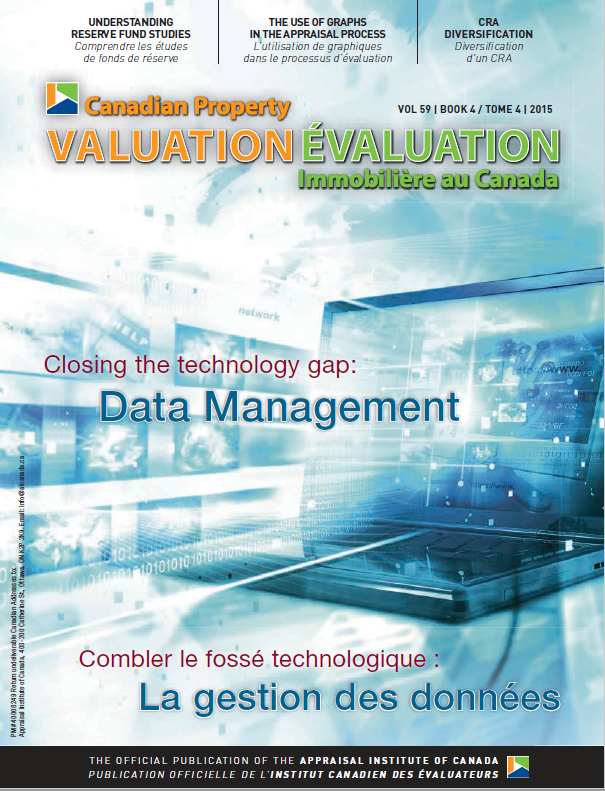Understanding reserve fund studies
Canadian Property Valuation Magazine
Search the Library Online



By Kari Benum, CRA, CRP, Dipl. J.A.; Ernie Paustian, AACI, P. App., RPA, CRP; and Dan Wilson, BCOMM, RI, AACI, P. App., Fellow, CRP
Introduction
Condominium and strata ownership continues to be a viable housing alternative for many Canadians. To protect the interests of the individual unit owners and the condominium corporations, the majority of Canadian provinces have enacted legislation requiring that condominium corporations partake in a reserve fund study (called a depreciation report in British Columbia). Condominium corporations are referred to as strata corporations in British Columbia, and comply with similar legislated requirements in regards to completing depreciation reports.
Contents of the reserve fund study
In basic terms, a reserve fund study is a report that assists condominium corporations in understanding what they own, how much money they have, the timing of potential replacements, future costs, and, ultimately, how to pay for the replacements when they are due.
A reserve fund study is a financial document that is meant to act as a guide to assist with planning corporate budgets. The study is not a technical audit and does not deal with detailed technical matters or invasive testing. Rather, this document takes a business approach to reserve fund management.
A reserve fund study generally includes the following:
- a physical inventory of all common property (including building systems such as roof systems, exterior walls, pavement and landscaping, etc.);
- an analysis of the observed condition, actual and effective age, remaining economic life, and current and future replacement costs for each component of common property;
- a determination of the level of reserves required to meet anticipated future costs;
- an analysis of the current balance of the reserve fund and how much the condominium corporation has been contributing historically; and
- development of funding models to assist the strata in reaching its funding goals.
The specific requirements vary slightly from province to province, with three cash flow models required in some provinces.
Benefits
The old adage is ‘buyer beware’ and the reserve fund study provides potential purchasers, investors and mortgage holders with the information they need to make informed decisions.
Some of the benefits of this type of study include predictable costs to the unit owner and a reduced likelihood of special levy or assessment. Unit values are likely to be enhanced, however, this does not necessary correspond on a dollar-to-dollar basis of the amount in reserve fund. The long-term marketability of condominium corporations with a sound, long-term financial vision suggests more stability than corporations with a less specific understanding of their future capital needs.
When asked why they are having a reserve fund study completed, most property managers and board members reply, “the last one is five years old” or “the Condominium Property Act requires one.” While both responses are correct, a reserve fund study should provide additional value beyond meeting the requirements of the applicable provincial Act. One of the responsibilities of a reserve fund planner is to work directly with the property manager and condominium board or council to assist them in appreciating the benefit of consistent planning for their current and future needs. As the board members change hands, the vision of the development may not always pass along under the same understanding as the previous board or council. Having a precise plan on hand allows for greater clarity as the development ages and new members come on board to assist as members of the board or council.
One of the goals of a reserve fund study should be to make the job of being a board or council member easier. As most board members would rather avoid the difficult task of voting to levy a special assessment, a good reserve fund plan should provide options that reduce the risk of a special assessment or minimize the impact, should a special assessment/levy be required.
The reserve fund study should provide funding options that allow for needed major repairs and replacement expenditures, while again reducing the potential of a special assessment. Contributions should be fair and equitable, balancing the needs of current and future unit owners.
During the annual budgeting process, the report should also be used as a time saving tool by the property managers and the board of directors/strata council.
Qualifications and competency
Many provinces recognize AIC members as having the qualifications and skills required to complete this work. Certified Reserve Planners (CRP) who are members of the Real Estate Institute of Canada are also generally recognized, as are quantity surveyors, engineers, architects, and other persons who meet the required qualifications and skills.
Competency is a well-discussed topic in the reserve fund planning industry. External parties and legislation may recognize AIC qualifications, however, the age-old question remains, what truly defines competency? Currently, the Appraisal Institute of Canada (AIC) has not developed specific courses of instruction relating to reserve fund studies. Members wishing to complete reserve fund studies are encouraged to obtain educational training through other organizations.
The Reserve Fund Planning Program (RFPP) is offered at Sauder Business School at the University of British Columbia, (http://www.sauder.ubc.ca/Programs/Real_Estate_Division/Credit_Programs_and_Professional_Development_Courses/Reserve_Fund_Planning) and the more comprehensive course material for the Certified Reserve Planner education program is provided through the Real Estate Institute of Canada (http://www.reic.ca/DESIGNATIONS/CRP-Certified-Reserve-Planner). There is a clear advantage for AIC members to complete such educational programs and align themselves with experts in the field who are qualified reserve fund planners.
With respect to insurance coverage, the AIC insurance program covers Canadian Uniform Standards of Professional Appraisal Practice (CUSPAP) compliant activities. Reserve fund studies form part of CUSPAP and are covered for competent AACI, P.App and CRA members.
Funding models
For reserve fund studies, there are four primary types of funding models:
The Baseline Funding Model and the Threshold Funding Model are similar in that the reserve fund balance is set at a predetermined amount. The primary goal of the Baseline Funding Model is to keep the reserve fund balance positive or above zero. A significant shortcoming with the Baseline Funding Model is that it assumes a perfect world where components fail exactly when expected. Should major components fail early, a special assessment is likely necessary.
With the Threshold Funding Model, a pre-determined amount is based on criteria that should be easily understandable by the owners. The criteria could include a percentage of annual reserve contribution indicated by the reserve fund study, the percentage of the annual operating budget, or even a percentage of how much it would cost to replace the building based on an insurance appraisal.
The Statutory Funding Model uses applicable legislation or statutes to determine the minimum amount of funds to be contributed to the reserve fund for major capital expenditures.
The biggest drawback of the Threshold and Statutory Funding models is that the age and condition of the components are not necessarily taken into consideration. If a significant component fails prematurely, the risk of a special assessment is again possible.
The goal of the Fully-Funded Model is to maintain the reserve balance at or very near 100% of the estimated total accrued depreciation for all of the common property components identified in the reserve fund study.
Although this sounds like a great solution, the biggest drawback with the Fully-Funded Model is that, if a condominium/strata corporation is fully-funded according to the reserve fund study, most condominium corporations would have too much money in their reserve fund. While the potential for a special assessment is much lower, the unit owner’s reserve fund contributions are larger than they need to be.
It is also important to remember that, unless a reserve fund is significantly over-funded, there is no funding model that will account for every scenario to avoid a special assessment.
Pooled versus non-pooled funding
There are varying schools of thought on funding methods for reserve funds and there are two primary methods: pooled funding and non-pooled funding.
Sometimes the pooled funding method is referred to as ‘cash flow’ or ‘pooling,’ while the non-pooled method is referred to as ‘straight-line’ or ‘non-pooling.’
The non-pooled or straight-line method determines a funding goal for each individual component without regard to the accumulation of funds for other components. It is like having a separate reserve account for each component: roofs, windows and concrete, etc. The funds from one component’s account cannot be used to pay for repairs or replacement of another component. For example, with non-pooled funding, the roofing account cannot be used for window replacement.
With pooled funding, the focus is on the total cash available which is required for the estimated replacement needs of all components. The pooled funding method requires an estimate of the funding requirements for at least the minimum period projected by the reserve fund study (typically 25-30 years, dependant on provincial requirements).
The annual contribution levels are then estimated to ensure that there is enough money in the reserve fund to cover all of the anticipated annual expenses, no matter in which year they occur. The biggest difference is that, instead of individual accounts for each component, the reserve funds are pooled.
When using the pooled funding method, there may not be a requirement for the unit owners to vote on the of use funds from one component to cover expenditures of another component, whereas, with the non-pooled method, a vote may be required (rules vary by province).
The non-pooled method may also result in a requirement for larger contributions by the unit owners and corresponding higher overall funding levels within the reserve fund.
Conclusion
As populations continue to grow in urban centres and cities and metropolitan areas continue to grow increasingly dense, the trend towards strata titled housing options continues to escalate.
Ultimately, provincial legislation dictates the specific requirements of the report and who may complete the assignment in each province. Each condominium/strata corporation then makes the decision as to which funding model and funding method best suits its needs.
As reserve fund planners, our goal is to guide condominium corporations toward a clear and viable capital replacement strategy, which, in turn, will assist in protecting their financial asset.
As AIC members, there are tremendous opportunities in developing our skill sets in this area and expanding our scope of practice into the reserve fund planning field.





